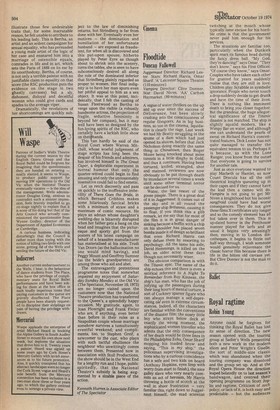Ballet
Royal ragtime
Robin Young
Anyone could be forgiven for thinking the Royal Ballet has lost its sense of direction. The new season opened with the touring group at Sadler's Wells presenting both a new work in the modern idiom and Peter Wright's Giselie, the sort of middle-size classic which was abandoned when the touring company ' was dissolved and the group set up. And at the Royal Opera House the direction leaped belatedly on to last season's bandwagon, and centred their opening programme on Scott Joplin and ragtime, Criticism of such policy, or lack of it, is both easy and predictable — but the audiences
enjoyed the programmes, so perhaps it would also be mistaken.
Christopher Bruce's first work for the Royal Ballet is called Unfamiliar Playground but the setting is, in fact, extremely familiar — the space enclosed within White lines which Nadine Baylis has made a sort of hallmark for British modern ballets of the all-white school to which this example ondistinguishedly adheres. Bruce has just become associate Choreographer of the Ballet Rambert, for whom he also dances, and it is no doubt good for him (classically trained) to have access to the stronger dancing resources which the Royal commands. The effect on the ballet-going Public, however, is just a bit like that of the party political broadcasts. You find that wherever you go you cannot get away from them. There is little in Unfamiliar Playground that Ballet Rambert could not manage as well, and in some cases better. I admit to prejudice: I do not like abstract ballets with uncomfortable movements and scores of the plink-plonk and warble variety which seem to go on Much too long and then just stop. I expect them of the Rambert: I can Only hope we will not have too Many more from the Royal. Giselle, patently, is another matter, and if the Royal is going backwards, who cares? Margaret Barbieri is a lovely actress-dancer (witness also her distrait Julia in Wedding Breakfast) who has been sadly neglected in the past. She is very nearly the perfect Giselle, a flawless period piece full of the Romantic virtues, and her supporting cast, Alain Dubreuil, David Morse and Kathryn Wade, matched her admirably. This is just the sort of thing the Royal does do well. Nor do I have any complaint about Elite Syncopations, though it IS certainly true that everybody else got round to Scott Joplin first. The deliberately slowed tempi of the kragtime numbers (five of the twelve by Joplin, the others by six of his contemporaries) and the trompe!'°eil gaudiness of Ian Spurling's Lollipop parade of costumes go with the tinkle of the honky-tonk to give a nicely calculated edge of nostalgia to what might have been merely a frivolous romp. , The costumes (colour on overall Leotards) are like exuberant body Painting, and give the dancers every encouragement to live their TrtsIt is almost invidious to single out performances but Michael Coleman's solo was intricate,IY difficult and taken with !Oounding confidence, Monica Mason was a grandly high-spirited ,,strutter, David Wall and Jennifer 0i7nney affected a delicate nevet6 13 Passion and the lofty Vergie errnan and diminutive Wayne SleeP got the loudest laughs in their totally indelicate duet.
The audience were wild for it, I think
rightly so. If Song of the Earth (jell. is MacMillan on a much N "ghe
r plane) came rather uncom `t'rtably afterwards, it got, from
rvia^
„ at least, the totally sombre
,.3'-'nuriitment it both needs and a'-`eserves. Perhaps Song is ballet ta SYncopations merely enter `nolent. Thanks to MacMillan, "Qwever, for both.



































 Previous page
Previous page